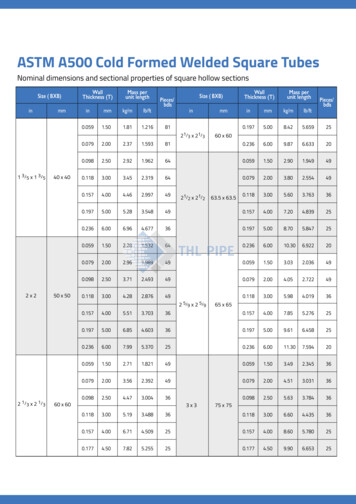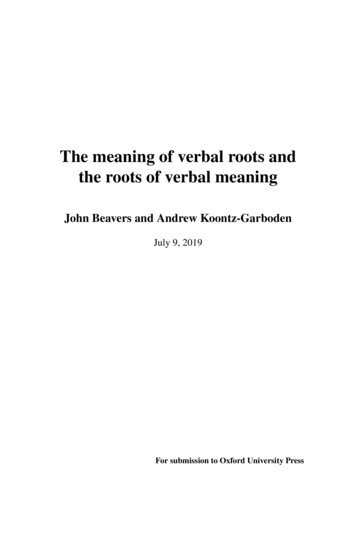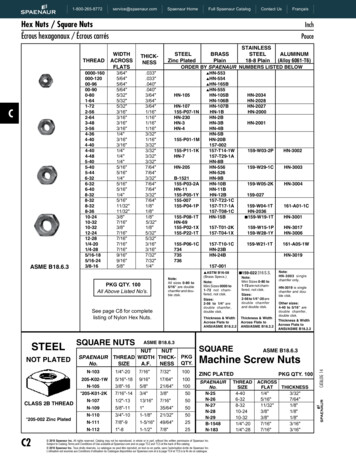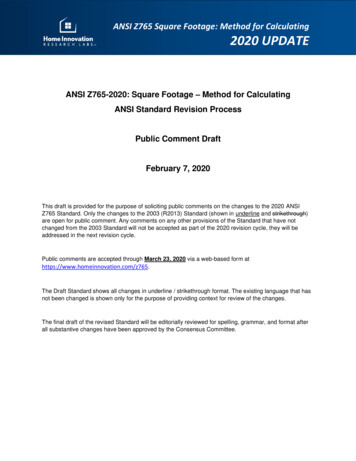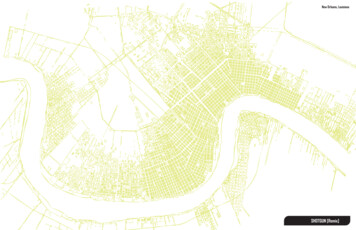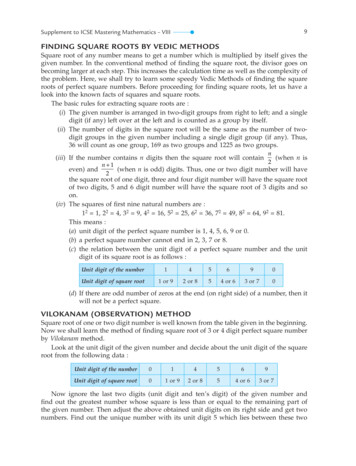
Transcription
9Supplement to ICSE Mastering Mathematics – VIIIFinding square roots by vedic methodsSquare root of any number means to get a number which is multiplied by itself gives thegiven number. In the conventional method of finding the square root, the divisor goes onbecoming larger at each step. This increases the calculation time as well as the complexity ofthe problem. Here, we shall try to learn some speedy Vedic Methods of finding the squareroots of perfect square numbers. Before proceeding for finding square roots, let us have alook into the known facts of squares and square roots.The basic rules for extracting square roots are :(i) The given number is arranged in two-digit groups from right to left; and a singledigit (if any) left over at the left and is counted as a group by itself.(ii) The number of digits in the square root will be the same as the number of twodigit groups in the given number including a single digit group (if any). Thus,36 will count as one group, 169 as two groups and 1225 as two groups.n(when n is2(iii) If the number contains n digits then the square root will containeven) andn 1(when n is odd) digits. Thus, one or two digit number will have2the square root of one digit, three and four digit number will have the square rootof two digits, 5 and 6 digit number will have the square root of 3 digits and soon.(iv) The squares of first nine natural numbers are :12 1, 22 4, 32 9, 42 16, 52 25, 62 36, 72 49, 82 64, 92 81.This means :(a) unit digit of the perfect square number is 1, 4, 5, 6, 9 or 0.(b) a perfect square number cannot end in 2, 3, 7 or 8.(c) the relation between the unit digit of a perfect square number and the unitdigit of its square root is as follows :Unit digit of the number145690Unit digit of square root1 or 92 or 854 or 63 or 70(d) If there are odd number of zeros at the end (on right side) of a number, then itwill not be a perfect square.vilokanam (observation) MethodSquare root of one or two digit number is well known from the table given in the beginning.Now we shall learn the method of finding square root of 3 or 4 digit perfect square numberby Vilokanam method.Look at the unit digit of the given number and decide about the unit digit of the squareroot from the following data :Unit digit of the number014569Unit digit of square root01 or 92 or 854 or 63 or 7Now ignore the last two digits (unit digit and ten’s digit) of the given number andfind out the greatest number whose square is less than or equal to the remaining part ofthe given number. Then adjust the above obtained unit digits on its right side and get twonumbers. Find out the unique number with its unit digit 5 which lies between these two
10Supplement to ICSE Mastering Mathematics – VIIInumbers and obtain the square of this unique number. If the given number is less than thissquare number then the smaller number among above obtained two numbers is the squareroot of the given number; otherwise another one is the required square root of the givennumber. Let us learn it with the help of some examples.Illustrative ExamplesExample 1. Find the square root of 841.Solution. The given number is 841.Its unit digit is 1, therefore, the unit digit of the square root will be 1 or 9.Ignoring the last two digits (unit digit and ten’s digit) we get 8.The greatest number whose square is less than or equal to 8 is 2.Adjusting above obtained two unit digits 1 or 9 to the right of 2, we get two numbers21 and 29.The unique number with unit digit 5 which lies between 21 and 29 is 25.(25)2 625(By Ekadhikena sutra : (25)2 (2 3) 25 625).Since841 625, therefore, the required square root is 29.Hence,841 29.Example 2. Find the square root of 4356.Solution. The given number is 4356.Its unit digit is 6, therefore, the unit digit of the square root will be 4 or 6.Ignoring the last two digits (unit digit and ten’s digit), we get 43.The greatest number whose square is less than or equal to 43 is 6.On adjusting above obtained two unit digits 4 or 6 to the right of 6, we get two numbers64 and 66.The unique number with unit digit 5 which lies between 64 and 66 is 65.(65)2 4225.(By Ekadhikena sutra : (65)2 (6 7) 25 4225)Since 4356 4225, therefore, the required square root is 66.Hence,4356 66.Example 3. Find the square root of 8649.Solution. The given number is 8649.Its unit digit is 9, therefore, the unit digit of the square root is 3 or 7.Ignoring the last two digits (unit digit and ten’s digit), we get 86.The greatest number whose square is less than or equal to 86 is 9.On adjusting above obtained two unit digits 3 or 7 to the right of 9, we get two numbers93 or 97.The unique number with unit digit 5 which lies between 93 and 97 is 95.(95)2 9025(By Ekadhikena sutra : (95)2 (9 10) 25 9025)Since 8649 9025, therefore, the required square root is 93.Hence,8649 93.
Supplement to ICSE Mastering Mathematics – VIII11Example 4. Find the square root of 7225.Solution. The given number is 7225.Its unit digit is 5, therefore, the unit digit of the square root is also 5.Ignoring the last two digits (unit digit and ten’s digit), we get 72.The greatest number whose square is less than or equal to 72 is 8.On adjusting above obtained two unit digits 5 to the right of 8, we get the numbers 85.Here, we are getting just one number 85, which is the required square root.Check : (85)2 (8 9) 25 7225.Hence, 7225 85.Exercise 3.3 (S)Find the square roots of the following perfect square number by Vilokanam method :1. 5292. 7293. 17644. 54765. 96046. 79217. 53298. 31369. 5625general vedic method of finding square rootsBy the general Vedic method, we can find the square root of a number consisting of anynumber of digits. Also, even if the number is not a perfect square number we can find itssquare root in decimal form up to the desired number of decimal places. However, for thepresent we will restrict up to six digit numbers which are perfect squares.Vedic method of finding the square root is similar to Straight Division. Here, thedivisor is exactly double of the first left digit of the square root. Since the biggest digit is 9,therefore, in this Vedic method of finding square root the biggest divisor can be 18. To getthe actual dividend from the gross dividend, the Duplexes of the further digits of the squareroot (second digit onwards from left) will have to be subtracted. Thus, this method is thecombination of Straight Division and Duplexes. Moreover, the quotient being a digit of asquare root can never be greater than 9 and the actual dividend at any stage should not bea negative number; in that case, we shall use altered remainders. Let us learn this methodwith the help of some examples.Illustrative ExamplesExample 1. Find the square root of 6724, use general Vedic method.Solution. Procedure :Step 1. Form the group of two-digits from right to left. Here, we get two groups67 28 . Separate the left group i.e. 67 by a vertical line. Leave one line space forwriting remainders and draw a horizontal line as in straight division. Drawa vertical line at the left side of the number to write the divisor. Thus, set theproblem as shown :Step 2. The left most group is 67. Find the maximum square67 2 4of a digit that can be subtracted from this group i.e. 67and write this digit below the horizontal line as the first 16 3 08 2 · 0digit of the square root.
12Supplement to ICSE Mastering Mathematics – VIIIHere, we can subtract maximum square of 8 which is 64. Write 8 as the firstdigit of the square root and prefix remainder 67 – 64 i.e. 3 to the next digit2 of the number as shown. The divisor is the double of first square root 8 i.e.2 8 16, write this divisor 16 to the left of vertical line from the number.Step 3. Next dividend is 32. This itself is actual dividend. Divide 32 by 16 to get 2 asquotient and 0 as remainder. Write this quotient digit 2 and the remainder 0 attheir respective places.Step 4. Next gross dividend 04 i.e. 4 andactual dividend 4 – duplex (2) 4 – 22 4 – 4 0.As the number consists of 4 digits, its square root will consist of 2 digits.Therefore, if the number is a perfect square then the work of finding squareroot is complete and 82 is the square root of 6724.To confirm this, write the decimal point in the quotient i.e. after the digit 2 ofthe square root and proceed in a similar way.Step 5. Actual dividend 0.Divide 0 by 16 to get 0 as quotient and 0 as remainder. This means that thework has been completed.\ 6724 82Example 2. Find the square root of 119716.Solution. Procedure :Step 1. Form the groups of two digits from left to right.Here, we have : 11 97 16 .Separate the left most group i.e. 11 from the remaining digits of the number bya vertical line and write the problem as shown :Step 2. Find the maximum square of a digit that11 9 7 1 6can be subtracted from 11. Here, we can6 2 5 5 3subtract maximum square of 3 which is3 4 6 · 0 09. Write 3 as the first digit of the squareroot below horizontal line and prefixremainder 11 – 9 i.e. 2 to the next digit 9 of the number. The divisor is 2 3 i.e.6. Write this divisor to the left of vertical from the number.Step 3. Next dividend is 29. This itself is actual dividend. Divide 29 by 6 to get 4 asquotient and 5 as remainder. Write the quotient 4 as the second digit of thesquare root and the remained 5 at their respective places.Step 4. Next gross dividend 57,actual dividend 57 – D (4) 51 – 42 41Divide 41 by 6 to get 6 as quotient and 5 as remainder.Check : Next gross dividend 51,actual dividend 51 – D (46) 51 – 2(4 6) 51 – 48 3.As the number consists of 6 digits, its square root will consist of 3 digits.Therefore, if the number is a perfect square then the work of finding squareroot is complete and 346 is the square root of 119716.To confirm this, write the decimal point in the quotient i.e. after the digit 6 ofthe square root and proceed in a similar way.
Supplement to ICSE Mastering Mathematics – VIII13Step 5. Divide 3 by 6 to get 0 as quotient and 3 as remainder.Write quotient digit 0 and remainder 3 at their respective places.Next gross dividend 36,actual dividend 36 – D (460) 36 – (2(4 0) 62) 0.Divide 0 by 6 to get 0 as quotient and 0 as remainder. This means that the workis completed.\119716 346Example 3. Find the square root of 405769.Solution. Procedure :40 5 7 6 9Step 1. Form the groups of two digits from left to 12 4 9 4 4right.6 3 7 · 0 0Here , we have : 40 57 69 .Write the problem as shown : 40 – 62 4, So 6 is the first digit of the squareroot and 4 is the remainder; divisor is 2 6 i.e. 12.Step 2. Actual dividend 4545 12 3, remainder 9.Check : Next gross dividend 97,actual dividend 97 – D (3) 97 – 32 88.\ 3 is the second digit of the square root and 9 is the remainder.Step 3. 88 12 7, remainder 4.Check : Next gross dividend 46,next actual dividend 46 – D (37) 46 – 2(3 7) 4.\ 7 is the third digit of the square root and 4 is the remainder.As the given number consists of 6 digits, so its square root consists of 3 digitsprovided the given number is a perfect square. Then the work of finding thesquare root is complete and 637 is the square root of 405769.To confirm this, write the decimal point in the quotient i.e. after the third digit7 of the square root and proceed as above.Step 4. 4 12 0, remainder 4.\ Quotient is 0 and remainder 4. Write 0 and 4 at their respective places.Next gross dividend 49,next actual dividend 49 – D (370) 49 – (2(3 0) 72) 0.Divide 0 by 12 to get 0 as quotient and 0 as remainder. This means that thework is completed.\405769 637Example 4. Find the square root of 361 by using general Vedic method.Solution. Procedure :Step 1. Form the groups of two digits from right to left.Here , we have : 3 61 .
14Supplement to ICSE Mastering Mathematics – VIIIThe left most group consists of only one digit. Write the3 6 1problem as shown :2 2 823 – 1 2, so 1 is the first digit of the square root and 21 9 · 0is the remainder;divisor is 2 1 i.e. 2.Step 2. Dividend 26. It is the actual dividend.We want to divide 26 by 2 to get quotient and remainder. But quotient beinga digit of the square root must be a one digit number. The biggest one digitnumber is 9. Let us try 9 for the quotient. Note that here we are using theconcept of altered remainder.26 2 9 8 i.e. 26 divided by 2 gives 9 as quotient and 8 as remainder.Write 9 as quotient i.e. the second digit of the square root and 8 as remainderat their respective places.Step 3. Next gross dividend 81,actual dividend 81 – D(9) 81 – 92 0.n 1As the given number consists of 3 digits, its square root consists of(whenn is odd) digits i.e.3 1 2 digits.22If the number is a perfect square, then the work of finding the square root iscomplete and 19 is the square root.To confirm this, write the decimal point in the quotient i.e. after the seconddigit 9 of the square root and proceed as above.Step 4. Divide 0 by 2 to get 0 as quotient and 0 as remainder. It means that the workis completed.\361 19Example 5. Find the square root of 56169.Solution. Procedure :Step 1. Form the groups of two digits from left to right.Here, we have : 5 61 69 .5 6 1 6 9We have a single digit 5 in the left most4 1 4 4 4group.2 3 7 · 0 0Write the problem as shown :5 – 22 1, so 2 is the first digit of the square root and 1 is remainder; divisor is2 2 i.e. 4.Step 2. Next dividend is 16. It is the actual dividend.16 4 4, remainder 0.Check : Next gross dividend 01 1,actual dividend 1 – D (4) 1 – 42 –15, not allowed.Therefore, we need altered remainder.16 4 3 4 i.e. 16 divided by 4 gives 3 as quotient and 4 as remainder.\ 3 is the second digit of the quotient and 4 is the remainder. Write 3 and 4 attheir respective places.
Supplement to ICSE Mastering Mathematics – VIII15Step 3. Next gross dividend 41,act
Finding squAre roots by Vedic Methods Square root of any number means to get a number which is multiplied by itself gives the given number. In the conventional method of finding the square root, the divisor goes on becoming larger at each step. This increases the calculation time as well as the complexity of the problem. Here, we shall try to learn some speedy Vedic Methods of finding the .

